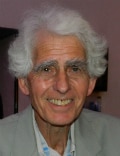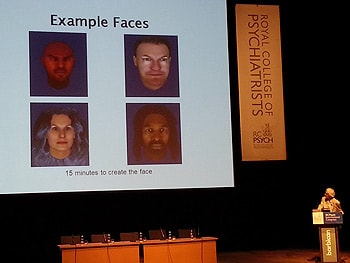Interesting. It's always good to see a non-drug approach to dealing with the symptoms of psychosis. I would like to see a larger study on this, and some way to make it scalable for therapists who don't have the resources to to do it in the same way as the study.
Below is a summary of the study from Medscape Medical News, and below the summary is the abstract for the full article, which is open access (follow the link below).
Full Citation:
Leff, J, Williams, G, Huckvale, M, Arbuthnot, M, & Leff, AP. (2014). Avatar therapy for persecutory auditory hallucinations: What is it and how does it work? Psychosis; 6:166-176. DOI: 10.1080/17522439.2013.773457
Novel 'Avatar Therapy' May Silence Voices in Schizophrenia
Deborah Brauser
July 03, 2014
LONDON ― A novel treatment may help patients with schizophrenia confront and even silence the internal persecutory voices they hear, new research suggests.
Avatar therapy allows patients to choose a digital face (or "avatar") that best resembles what they picture their phantom voice to look like. Then, after discussing ahead of time the things the voice often says to the patient, a therapist sits in a separate room and "talks" through the animated avatar shown on a computer monitor in a disguised and filtered voice as it interacts with the patient.
In addition, the therapist can also talk by microphone in a normal voice to coach the patient throughout each session.
In a pilot study of 26 patients with treatment-resistant psychosis who reported auditory hallucinations, those who received 6 half-hour sessions of avatar therapy reported a significant reduction in the frequency and volume of the internal voices ― and 3 reported that the voices had disappeared altogether.
"Opening up a dialogue between a patient and the voice they've been hearing is powerful. This is a way to talk to it instead of only hearing 1-way conversations," lead author and creator of the therapy program Julian Leff, MD, FRCPsych, emeritus professor at the Institute of Psychiatry in London, told meeting attendees.

Dr. Julian Leff
"As the therapist, I'm sharing the patient's experience and can actually hear what the patient hears. But it's important to remind them that this is something that they created and that they are in a safe space," Dr. Leff told Medscape Medical News after his presentation.
Two presentations were given here at the International Congress of the Royal College of Psychiatrists (RCPsych) 2014 the day after the study results were released in the print edition of Psychosis.
Regaining Control
According to the investigators, 1 in 4 people who hear phantom voices fail to respond to antipsychotic medication.
Dr. Leff explained that this program started a little more than 3 years ago, after he had retired "and could start thinking clearly again." He had been interested in the phenomenon of phantom voices for more than 40 years.
"Our mind craves meaningful input. That's its nourishment. And if it's deprived of nourishment, it pushes out something into the outside world," he said. "The aim of our therapy is to give the patient's ego back its mastery over lost provinces of his mental life."
The researchers used the "off-shelf programs" Facegen for the creation of the avatar faces and Annosoft LIP-SYNC for animating the lips and mouth. They also used a novel real-time voice-morphing program for the voice matching and to let the voice of a therapist to be changed.
In fact, Dr. Leff reported that one option the program provided changed his voice into that of a woman.
After a patient chose a face/avatar from among several options, the investigators could change that face. For example, 1 patient spoke of hearing an angel talk to him but also talked about wanting to live in a world of angels. So the researchers made the avatar very stern and grim so that the patient would be more willing to confront it.
Another patient chose a "red devil" avatar and a low, booming voice to represent the aggressiveness that he had been hearing for 16 years.
For the study, 26 participants between the ages of 14 and 74 years (mean age, 37.7 years; 63% men) were selected and randomly assigned to receive either avatar therapy or treatment as usual with antipsychotic medication.
 Dr. Julian Leff shows examples of faces used in avatar therapy at RCPsych 2014.
Dr. Julian Leff shows examples of faces used in avatar therapy at RCPsych 2014.
The length of time for hearing voices ranged from 3.5 years to more than 30 years, and all of the patients had very low self-esteem. Those who heard more than 1 voice were told to choose the one that was most dominant.
Pocket Therapist
During the sessions, the therapist sat in a separate room and played dual roles. He coached the participants on how to confront and talk with the avatars in his own voice, and he also voiced the avatars. All of the sessions were recorded and given to the participants on an MP3 recorder to play back if needed, to remind the patients how to confront and talk to the auditory hallucination if it reappeared.
"We told them: It's like having a therapist in your pocket. Use it," said Dr. Leff.
All of the avatars started out appearing very stern; they talked loudly and said horrible things to match what the patients had been reportedly experiencing. But after patients learned to talk back to the faces in more confident tones, the avatars began to "soften up" and discuss issues rationally and even offer advice.
Most of the participants who received avatar therapy went on after the study to be able to start new jobs. In addition, most reported that the voices went down to whispers, and 3 patients reported that the voices stopped completely.
The patient who confronted the red devil avatar reported that the voice had disappeared after 2 sessions. At the 3-month follow-up, he reported that the voice had returned, although at night only; he was told to go to bed earlier (to fight possible fatigue) and to use the MP3 player immediately beforehand. On all subsequent follow-ups, he reported that the voice was completely gone, and he has since gone on to work abroad.
Another patient who reported past experiences of abuse asked that his avatar be created wearing sunglasses because he could not bear to look at its eyes. During his sessions, Dr. Leff told him through the avatar that what had happened to the patient was not his fault. And at the end of 5 sessions, the phantom voice disappeared altogether.
Although 1 female patient reported that her phantom voice had not gone away, it had gotten much quieter. "When we asked her why, she said, 'The voice now knows that if it talks to me, I'll talk back,' " said Dr. Leff.
"These people are giving a face to an incredibly destructive force in their mind. Giving them control to create the avatar lets them control the situation and even make friends with it," he added.
"The moment that a patient says something and the avatar responds differently than before, everything changes."
In addition, there was a significant reduction in depression scores on the Calgary Depression Scale for Schizophrenia and in suicidal ideation for the avatar participants at the 3-month follow-up assessment.
A bigger study with a proposed sample size of 140 is currently under way and is "about a quarter of the way complete," Dr. Leff reports. Of these patients, 70 will receive avatar therapy, and 70 will receive supportive counseling.
"In order for others to master this therapy, it is necessary to construct a treatment manual and this has now been completed, in preparation for the replication study," write the investigators.
"One of its main aims is to determine whether clinicians working in a standard setting can be trained to achieve results comparable to those that emerged from the pilot study," they add.
"Fascinating" New Therapy
"I think this is really exciting. It's a fascinating, new form of therapy," session moderator Sridevi Kalidindi, FRCPsych, consultant psychiatrist and clinical lead in rehabilitation at South London and Maudsley NHS Foundation Trust in the United Kingdom, told Medscape Medical News.

Dr. Sridevi Kalidindi
"I think it is a novel way of approaching these very challenging symptoms that people have. From the early results that have been presented, it provides hope for people that they may actually be able to improve from all of these symptoms. And we may be able to reduce their distress in quite a different way from anything we've ever done before."
Dr. Kalidindi, who is also chair of the Rehabilitation Faculty for the Royal College of Psychiatrists, was not involved with this research.
She added that she will be watching this ongoing program "with great interest."
"I was very enthused to learn that more research is going on with this particularly complex group," said Dr. Kalidindi.
"This could be something for people who have perhaps not benefitted from other types of intervention. Overall, it's fantastic."
International Congress of the Royal College of Psychiatrists (RCPsych) 2014. Presented in 2 oral sessions on June 26, 2014.
Medscape Medical News © 2014 WebMD, LLC
* * * * *
Bagaimana Menarikkan Article Pada Hari Ini . BLUE.Jangan Lupa Datang Lagi Untuk Membaca Article Yang lebih Menarik Pada Masa Akan Datang/Avatar therapy for persecutory auditory hallucinations: What is it and how does it work?
Open access
Julian Leff, Geoffrey Williams, Mark Huckvale, Maurice Arbuthnot & Alex P. Leff
Abstract
We have developed a novel therapy based on a computer program, which enables the patient to create an avatar of the entity, human or non-human, which they believe is persecuting them. The therapist encourages the patient to enter into a dialogue with their avatar, and is able to use the program to change the avatar so that it comes under the patient’s control over the course of six 30-min sessions and alters from being abusive to becoming friendly and supportive. The therapy was evaluated in a randomised controlled trial with a partial crossover design. One group went straight into the therapy arm: “immediate therapy”. The other continued with standard clinical care for 7 weeks then crossed over into Avatar therapy: “delayed therapy”. There was a significant reduction in the frequency and intensity of the voices and in their omnipotence and malevolence. Several individuals had a dramatic response, their voices ceasing completely after a few sessions of the therapy. The average effect size of the therapy was 0.8. We discuss the possible psychological mechanisms for the success of Avatar therapy and the implications for the origins of persecutory voices.






Posting Komentar